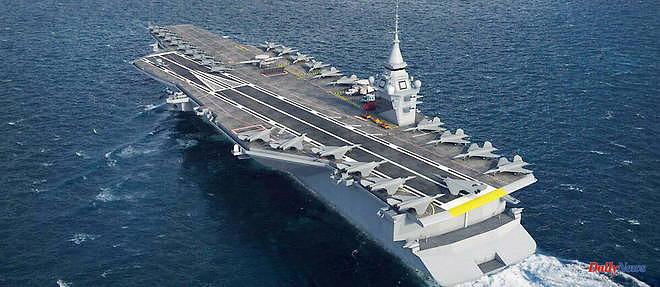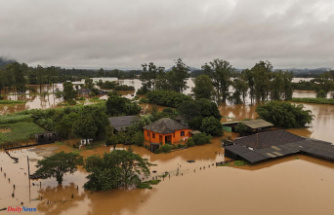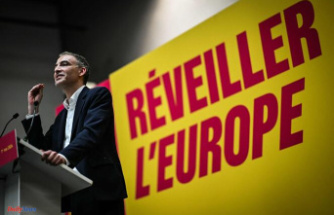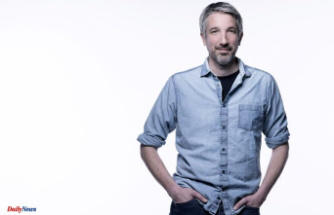The construction of the new generation aircraft carrier (PANG) which is to replace the Charles de Gaulle, currently in service, will begin in 2025. This was announced by the Minister of the Armed Forces, Sébastien Lecornu, in an interview with Le Parisien published on April 1st. This program extends over more than 15 years to enable France to renew the largest ship in its fleet in 2038. France is the only country, with the United States and its eleven ships, to be able to boast of owning a nuclear aircraft carrier. The Charles de Gaulle had been launched in 2001.
The idea of replacing it with two ships has long been mooted: such ships must be put in dry dock for 18 months for a major technical shutdown (ATM) every seven to nine years to be modernized and reloaded with nuclear fuel. Having two aircraft carriers would have allowed France to ensure permanence at sea, all the more important since the aircraft carrier carries nuclear weapons and is therefore one of the three vectors of French deterrence. The option is now ruled out: the PANG will probably be unique.
An aircraft carrier is a real floating air base capable of traveling 1,000 kilometers a day on the seas. The PANG will be a continuation of the missions already carried out by the Charles de Gaulle: so-called "freedom of movement" missions, which consist of navigating in contested areas while respecting international law governing navigation in non-territorial waters , for example in the China Sea.
The PANG, like its predecessor, will also be a vector of French nuclear deterrence since the hunters it embarks are capable of carrying atomic weapons. More generally, it is a formidable tool of power and diplomacy: in December 2001, France was already carrying out air missions over Afghanistan thanks to the emergency projection of the Charles de Gaulle in the region. The latter was also the spearhead of Operation Harmattan launched by France in Libya in March 2011.
Some commentators question the usefulness of an aircraft carrier in the age of hypervelocity missiles. These maneuvering weapons, very fast, are today very difficult to intercept and could put the building out of action in the first hours of a major conflict. During a parliamentary hearing, the Chief of the Naval Staff, Admiral Vandier, nevertheless recalled that the aircraft carrier is constantly evolving with a large carrier group.
"If the Charles de Gaulle was installed at Place de la Concorde, the first air defense frigate would be located on the ring road, the anti-submarine warfare frigate would be in Lyon, the SNA [nuclear attack submarine] in Corsica, the Hawkeye [aircraft watch, editor's note] in Sardinia, "he explained to underline the extent of the protective device that accompanies the aircraft carrier.
The final architecture is not yet known, but the PANG should be able to carry around thirty aircraft, ranging from on-board fighters to the E2C Hawkeye maritime lookout aircraft. It will initially carry Rafale Marine until the 2040s, when they should be replaced by the future Franco-German fighter, the Scaf (Air Combat System of the Future). All of these planes require a catapult to launch from the flight deck. On the Charles de Gaulle, they are steam powered and of American design. On the PANG, the choice was made to switch to an innovative system: electromagnetic catapults, again American. The United States is equipping its new buildings with it and is experiencing many problems with the system's youth, but Paris estimated that the technology will be more mature when the PANG is commissioned.
The studies were officially launched in 2018 with a budget of 40 million euros per year. The total is estimated at around 10 billion euros, although these costs are highly variable and depend on many factors, including the potential delay in such an industrial program, which mobilizes thousands of jobs for years. While the military programming law for the next five years (LPM 2024-2030) is soon to be unveiled, Sébastien Lecornu announced that 5 billion euros had already been sanctuary there for the project. An essential effort for what he describes as "a 75,000-ton cathedral of technology and human skill: an over-water factory packed with steam, electronics, nuclear," carrying 2,000 sailors and airmen.
Naval Group, prime contractor on the project, unveiled the design of the PANG at the Euronaval 2022 show. With two runways and an island, it incorporates nothing revolutionary in terms of aesthetics, except for a worked superstructure to be as stealthy as possible. The Charles de Gaulle replacement will be 75,000 tons fully loaded, almost double that. With a length of 300 meters, it will approach the American nuclear aircraft carriers, giants of the seas exceeding all 100,000 tons. The design has already been tested using a 10 meter mock-up by Naval Group.
New artist views of the Next Generation Aircraft Carrier (PANG), unveiled today at Euronaval. With lots of NGF and Rafale on it @navalgroup @DGA @Technicatome pic.twitter.com/TEPoOGGQtq
The name has not yet been revealed and will soon be chosen by President Emmanuel Macron. Some voices rise to name it the "Richelieu", in reference to the father of the French military navy, under Louis XIII. This name was already borne by a battleship, the flagship of the French navy in the Second World War. It was also one of the names considered to baptize the Charles de Gaulle in 1986 before Jacques Chirac changed it in 1987. Anyway, its registration will be "R92", to follow that of the current aircraft carrier, the R91.












